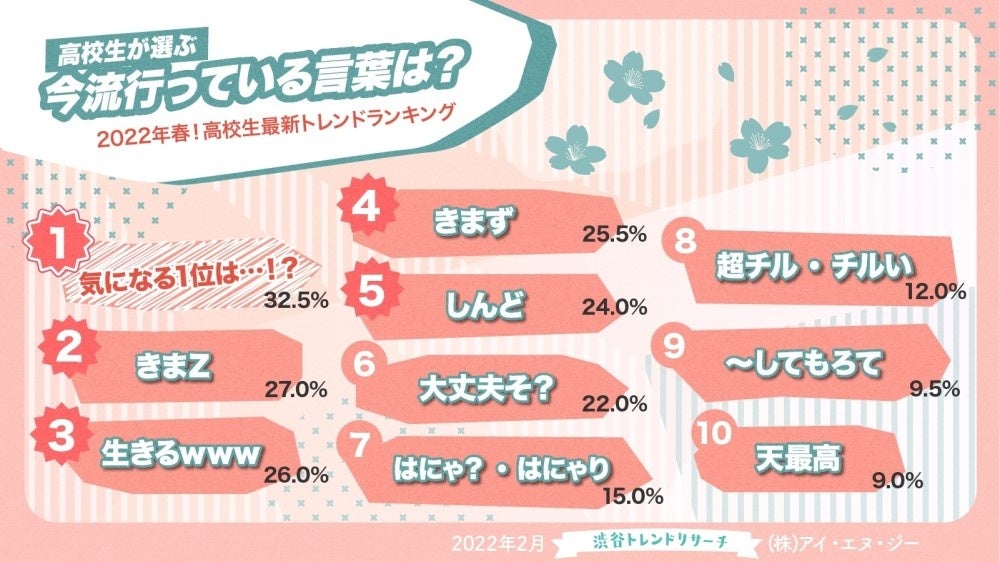Keeping up with the kids: Japanese high schoolers’ most popular slang of Spring 2022

Would you be surprised if most of these trendy words came from social media?
Language changes all the time, and in today’s age of social media, trends are shifting faster, and with more influences, than ever before. Last year’s list of hot words, for example, featured an array of slang coined by Japanese Olympic athletes and otaku, as well as a few buzzwords based on trending topics.
Now there’s a new list of trending slang, collected in a survey done by teen marketing company ING. 200 male and female high schoolers in the Kanto region were asked to name the words that are most popular right now, and they were all compiled into a ranking of the top 10 most popular words of Spring 2022.

10. Tensaiko
A combination of the words “tensai” (“genius”) and “saiko” (“the best”), this is a hot word coined by boyband idol Daigo Nishihata of the Johnny’s group Naniwa Danshi. Since it’s made up of two words that describe something that’s impressive and awesome, it’s kind of the ultimate compliment, to be honest.
9. ~shitemorote
This is an informal way of saying “~shite moratte,” which means “have (someone) do something for you.” “~shitemorote” was coined by Kansai-based Japanese YouTube duo Paparapys, and their popularity made the unusual twist of the phrase go viral.
8. Cho Chiru / Chirui
Coming from the English word “chill”, these words reflect a state of relaxation. The “cho” in “Cho chiru” means “super” or “extremely”, so you could use this to reflect when you’re feeling super chill, and “chirui” is the adjective form you can use to describe a place that has a good vibe.
7. Hanya / Hanyari
A silly substitution for “are?”, “hanya” is an interjection used when you’re confused by something. Similarly, “hanyari” is the state of being confused by something. Both were made popular by celebrity Rei Maruyama, who frequently uses them as her skit personality, Chiaki Inoue, on her YouTube channel, or when acting like an airhead (like in the video above).
6. Daijoubuso?
Also coming from YouTube duo Paparapys, this word is somewhat cheeky as it asks whether someone or something is okay or not. The phrase come from taking daijoubu, meaning “OK,” tacking on sou, (“probably”), and then lopping off the -u at the end for a snappier sound.
▼ As exemplified in the title, “The Mentaiko Cheese Fami-Chiki is so good, are we okay?”
5. Shindo
A shortening of the adjective “shindoi”, which usually means “exhausting” or “exhausted”. However, shortened in this way by Japanese Generation Z, it is actually to mean “funny” or “interesting”! Maybe because it’s so interesting it just zaps the energy out of you?
4. Kimazu
This was populated by another Japanese YouTuber, Aya Nakamichi, who has a habit of saying “kimazui kimazui”, which she uses when describing an awkward situation. Last year, “Kimazui kimazui” ranked on summer’s most popular words, but it seems like this year it’s been shortened for convenience.
3. Ikiru www
A TikTok video created this hashtag when the user recommended people use this instead of “shinu www” when something bad happens. “Ikiru” means “I’m going to live” while “Shinu” means “I’m going to die”, so the humorous reversal of the words is probably what made this hashtag so popular. “www”, by the way, is a Japanese version of “lol” (because it looks like blades of grass), making it a kind of ironic hashtag that all the kids seem to be using.
2. KimaZ
Pronounced “kimazetto”. Like Aya Nakamichi’s “kimazui kimazui”, it means “awkward”. It was coined by YouTuber Toua, who often uses “kimaZ” in awkward situations.
1. Ase-Ase
Another word popularized by YouTuber Aya Nakamichi, used humorously when one is in a pinch or worried or stressed by something. Teens these days use it in speech as well as writing, but when used in writing, it’s specifically written with half-size katakana for visual effect (アセアセ).
Unsurprisingly, the majority of the top words teens are using these days are inspired by social media, specifically popular YouTube and TikTok influencers. Social media has become a huge influence on Gen Z, which is evident in the way they dress as well as the way they talk. We can only hope that we older generations can keep up!
Source: PR Times
Top image: PhotoAC
Insert image: PR Times
● Want to hear about SoraNews24’s latest articles as soon as they’re published? Follow us on Facebook and Twitter!
Credit:

0 comments:
Post a Comment